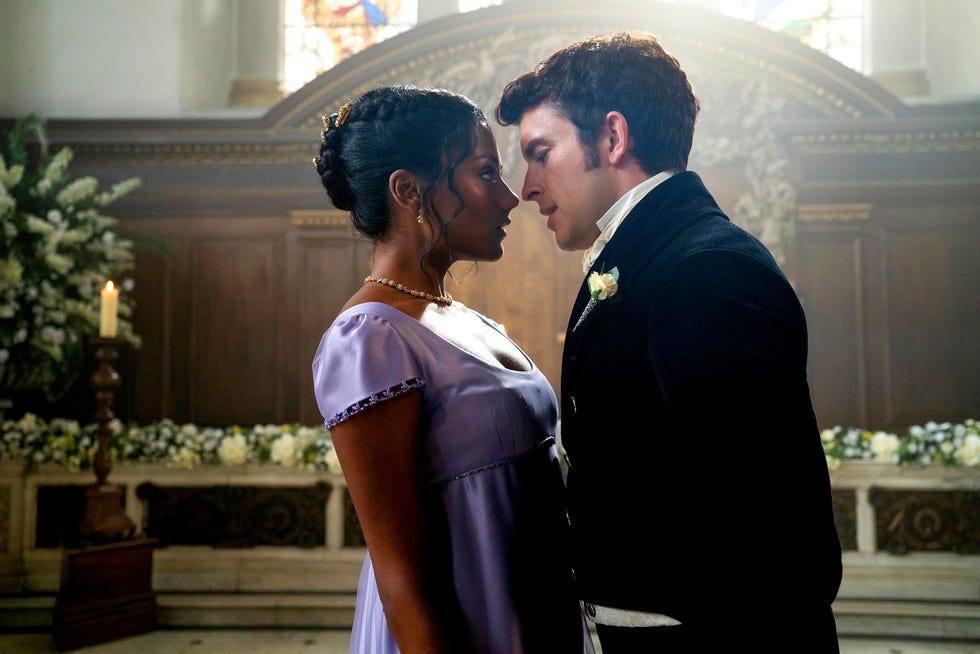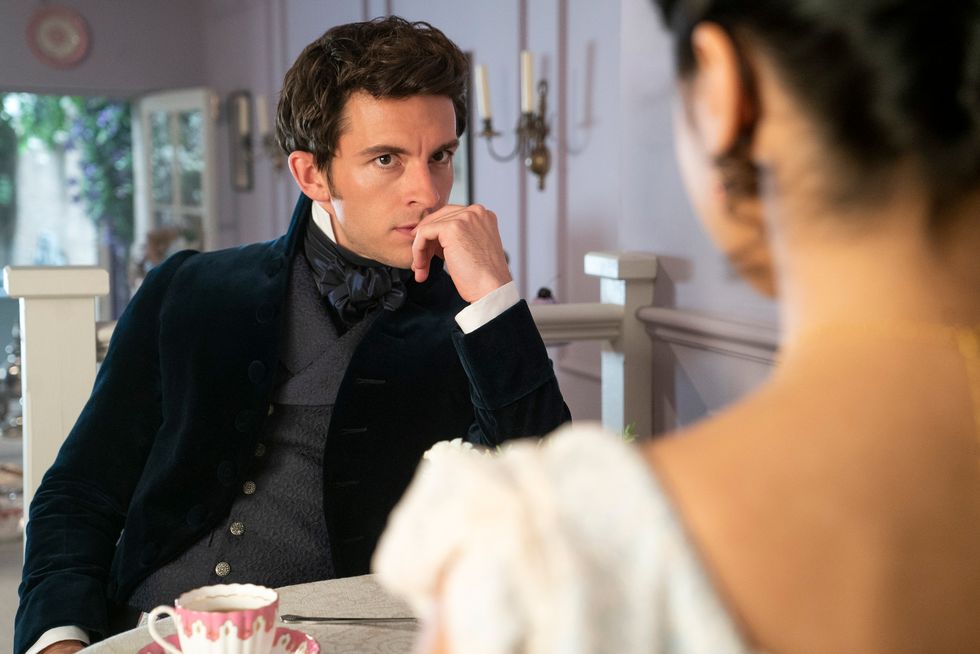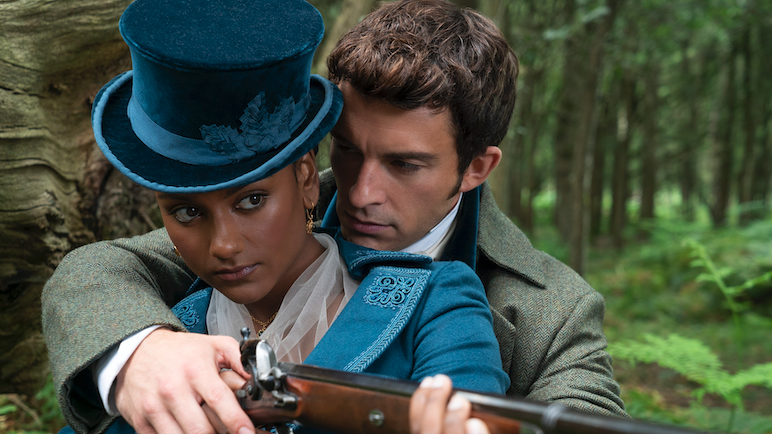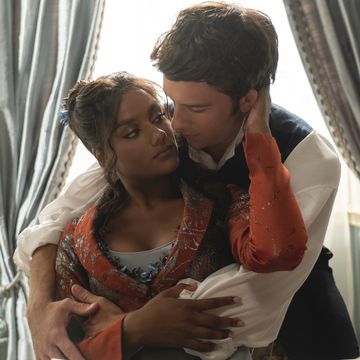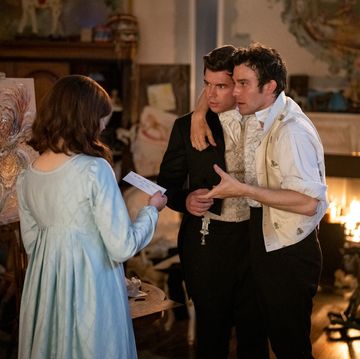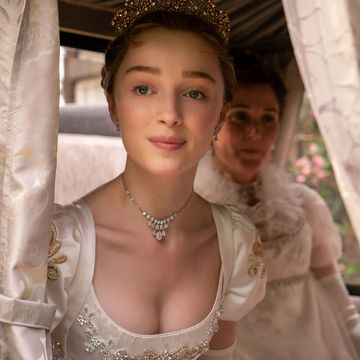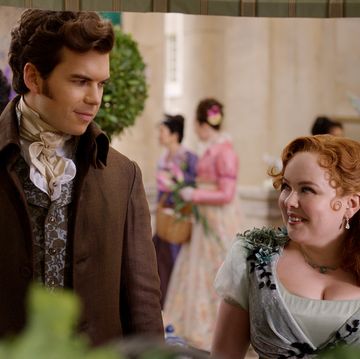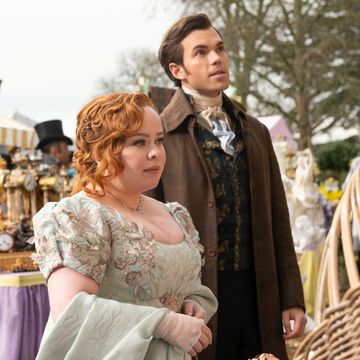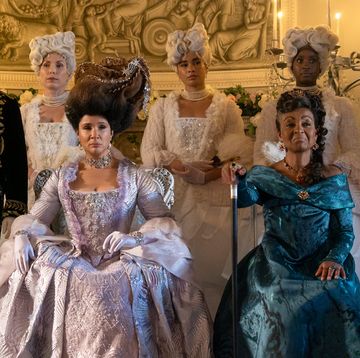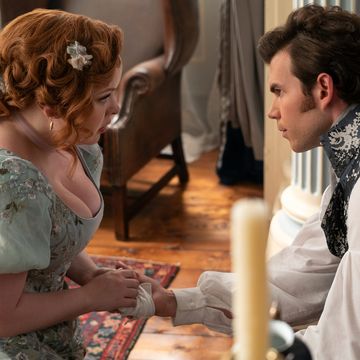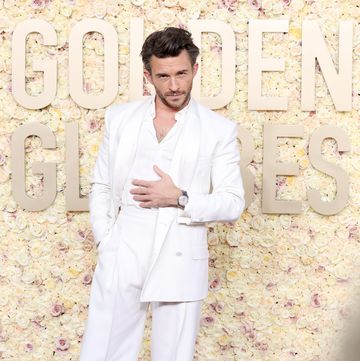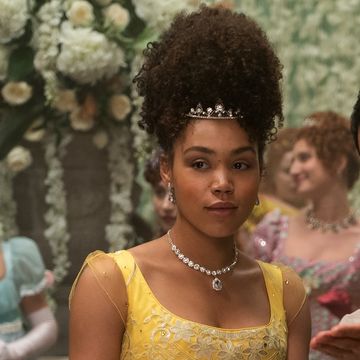More than 25 years ago, Colin Firth made a splash when he played one of literature’s great romantic figures in the BBC Pride and Prejudice miniseries. Since then, Firth’s version of Darcy has become a visual shorthand for the brooding Regency love interest, a fraternity which recently got a new injection of smoldering poster boys in Netflix’s breakout historical romance, Bridgerton. The Firth-as-Darcy aesthetic is a thread that continues in Bridgerton’s second season through overt wet shirt nods but also more subtle references.
Timing, costume, and actor all played a role in propelling this vision into the pop culture stratosphere, but Firth was far from the first to play Mr. Darcy. A lavish MGM movie—that was adapted from a stage production of Austen’s novel—saw Sir Lawrence Olivier take on the role in 1940. For that production, legendary designer Adrian took a page out of the Gone with the Wind sartorial playbook with its array of exaggerated hooped skirts, puffed sleeves, and big bows. Setting the story a few decades later allowed Adrian to dial up the grandeur; however, lifting it out of the Regency era left a gap for a definitive take on Austen’s novel, and Firth has more than filled those boots in 1995. Costume designer Dinah Collin won an Emmy for her work on the BBC series, which has since inspired a generation of Regency adaptations—not to mention the string of winks to the transformative post-swim moment.
“Every period makes period drama that reflects the time it's made,” Hilary Davidson, dress historian and author of Dress in the Age of Jane Austen: Regency Fashion tells Town & Country over Zoom. An explosion of Austen adaptations in the '90s reshaped the Regency image through a contemporary lens, and the reign of Firth as the originator of the Darcy look continues to present day.
One character cashing in on this cultural currency is Anthony Bridgerton (played by Jonathan Bailey) with his thick chestnut brown curls, a self-serious aura, and the quick dip he takes in the second season. The image of the eldest Bridgerton sibling in a practically sheer soaking shirt is not only a direct reference to the iconic Firth portrayal, but it also reinforces an imagined moment. "That shot of him climbing out of the water isn't in Pride and Prejudice, there is no Colin Firth coming out of the water and yet that's the one that people do,” Davidson points out. This pop culture misnomer also speaks to how Austen is now interchangeable with Regency (even when the author doesn’t apply) and the enduring power Firth’s portrayal of this literary figure has.
Here we talk about the page-to-screen interpretations of Darcy, the pond moment that never happened, and why Firth’s portrayal continues to inspire.
From Austen’s Words to the Steamy Screen
Mr. Fitzwilliam Darcy is synonymous with the buttoned-up aloof archetype, but in Jane Austen’s 1813 novel, not a stitch of his clothing is described. “You can project upon him whatever you want,” says Davidson about the lack of superficial garment detail. Austen only provides that Darcy “drew the attention of the room by his fine, tall person, handsome features, noble mien.” Given this blank slate, Firth’s Darcy found the “perfect pitch between elegant restraint and being unable to be restrained,” says the dress historian. Davidson also credits this as part of the appeal, "He is all surface, reputation, appearance, and pride. The sense of who he is on the interiority takes a while to encounter and be let out. And they reflect that well in the costuming.”
Similar to how Firth’s Darcy is a visual reference for the Regency male, Austen is shorthand for anything set in Regency England, even if it doesn’t reflect the content of the author’s literary contribution. “This has got nothing to do with Austen except it's in the same period,” Davidson says about the Netflix series. “Bridgerton is Bridgerton and it's a fantasy of an aristocratic Regency world, which is very different from the middle-classness of Austen's world,” she observes.
Austen scholar Roger Sales referred to the mythic and timeless cinematic landscape of these adaptations as “Austenshire.” Davidson uses this description to explain the indelible mark Colin Firth’s depiction left—including the moment that didn’t happen. “The connection is not so much with Austen the novels but definitely with Austenshire, and so in a sense, Darcy coming out of the water is pure Austenshire,” Davidson explains. “Because not only does it not exist in the books, it doesn't even exist in the thing. It's part of that imaginary cinematic landscape and then it becomes a reference in itself—an arch knowing reference.”
The Darcy Water Myth
If you watch the 1995 BBC Pride and Prejudice adaptation, you might be surprised by the brevity of the pond scene. In fact, Firth didn’t even dive into the water because it was considered unsafe and a stuntman did it in his place. “The only time Colin Firth got at all damp was in the walking back scene and they just sprayed him with water. He never even touched the pond,” notes Davidson. An imaginary version of this scene is burned into our collective minds and publicity campaigns like the 12-foot tall fiberglass statues in the Serpentine Lake in London’s Hyde Park in 2013 have further fueled this misconception.
Recent comments made by Bridgerton’s costume designer Sophie Canale to Fashionista highlight the ubiquity of this portrayal and watery moment: "Whenever you see that kind of Regency man, everyone's automatically going to go to [Firth as Mr. Darcy] because it's such a famous scene." Davidson refers to the mythic qualities of “Colin Firth rising like Poseiden from the pond” and how movies like Lost in Austen further perpetuate this fantasy by referencing something that didn’t happen. Not only is Bridget Jones’ Diary is loosely based on Pride & Prejudice, but the character of Mark Darcy was inspired by Firth’s portrayal in the BBC series. Who better to play this character in the movie adaptation than Colin Firth himself! A contemporary spin on the pond scene (a Titanic reference is also thrown in the mix) speaks to the popularity of this portrayal but with one notable change. Hugh Grant and not Firth ends up soaked in this boating mishap—although the pair do have a scuffle in a water fountain in the sequel.
Eroticism and the Athletic Body
Despite Bridgerton’s roots in the romance genre, it has yet to capture quite how tight the pantaloons of the era were—“the potential for visible genitalia is never ever done in costume dramas”—and with the rise in Regencycore fashion influence, Davidson believes there is a bar that no one has hit yet, "I'm a serious historian at other times but nipples and junk. I want nipples and junk. Because until we get to that we are not even close to the Regency.”
The closest this season of Bridgerton gets to a “free the nipple” public moment is when Anthony makes his grand splash and immediately strips off his jacket in frustration. In doing so, he reveals a cotton shirt that is more transparent than traditional linen would have likely been during this period, Davidson remarks. This is far from the first time his uncovered neck has been visible to a Sharma sister as in the previous episode; an accidental nighttime rendezvous with Kate (Simone Ashley) in the library flusters the once levelheaded Bridgerton. A line can be drawn between the sisters seeing his bare skin for the first time and Elizabeth Bennett’s (Jennifer Ehle) encounter with a damp semi-dressed Darcy in the wild. “Darcy is poised, cool, controlled. And that's what's so hot about him because then he breaks down,” says Davidson. “You get to rumple his collar and in a sense that shirt scene embodies this sense that all of that well-put-together composure can be ruffled—literally and figuratively.”
A notable difference between Bridgerton and Pride & Prejudice is that Firth’s post-swim sequence “was never meant to be an erotic moment, ever,” explains Davidson. “It was part of the physicality of it to show Darcy at home on his estate: he's comfortable, he's been riding and it seems natural he'll just jump into the pond.” Rather than dialing up the yearning, it was meant to highlight British awkwardness when Darcy unexpectedly encounters Elizabeth in what he believed was a private space. Whereas Bridgerton has no such illusions about the overt eroticism as Edwina Sharma’s reaction to Anthony’s see-through shirt is akin to her seeing him topless.
It isn’t only Mr. Darcy who was flustered by this post-swim stroll. Audience reaction can’t always be predicted and it has been more than two decades since Firth-as-Darcy fever first took hold. Rather than deny the influence, Bridgerton dives in both feet first in its celebration of this revelatory interaction, and there is no denying Darcy’s fingerprints are all over Anthony Bridgerton. “It's not possible to do a Regency show now without the shadow of Colin Firth,” observes Davidson. “So they may as well lean into it because the connection is already made.”

